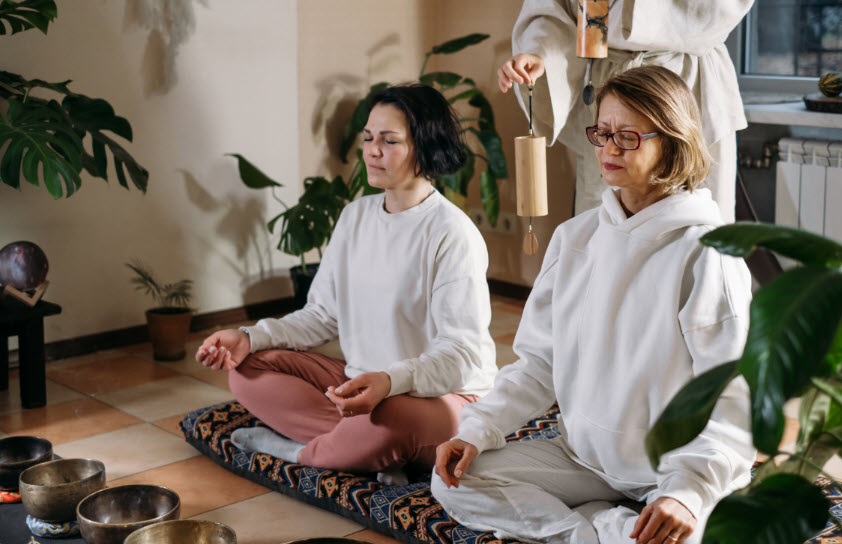
We live in a world that stress our mental wellness by constantly demanding more of us. Deadlines, expectations, and never-ending to-do lists pull us in every direction.
It leaves us feeling disconnected from ourselves.
The weight of it all builds up until, one day, it feels impossible to breathe. I’ve been there.
The suffocating pressure of juggling family, work, and the pursuit of personal peace. I thought I was having a heart attack.
But here’s the truth I’ve learned from my own journey that mindfulness is the key that unlocks the door to mental wellness.
It’s a practice that blends ancient wisdom with modern science. It offers a powerful tool to manage stress and anxiety.
More importantly, it can create lasting peace within.
The Unseen Power of Mindfulness

Mindfulness isn’t just about sitting cross-legged on a mat, breathing deeply, and trying to “clear your mind.”
While this may be a part of the mental wellness practice, it’s much more than that. It’s about being present.
It’s about tuning into the here and now—your breath, your thoughts, your body, your feelings—without judgment or distraction. It works in union to ensure mental wellness.
When I first heard about mindfulness, I thought it sounded too simple.
Yet, as I explored it more, I realized how profound this practice is. It’s the art of observing, not reacting.
In this busy world, it’s the one space where we can truly listen to ourselves. I found that it’s the first step to healing and mental wellness.
Scientifically speaking, mindfulness has been shown to reduce stress, lower anxiety, and even improve overall mental wellness.
Research has found that mindfulness can physically change the brain, increasing gray matter in areas associated with emotional regulation and memory (Davidson & McEwen, 2012).
This isn’t just abstract theory—it’s backed by science.
Studies show mindfulness makes our mental wellness more resilient.
We’re also more able to cope with life’s inevitable trials.
A Personal Experience: Finding Stillness Amid the Chaos
I remember a time when I felt completely overwhelmed, drowning in everything I had to do.
I was juggling multiple responsibilities, and I couldn’t find a moment to breathe.
One night, as I sat in my favorite chair, trying to unwind, I caught myself holding my breath.
My thoughts were racing, my body was tense, and I felt disconnected from myself.
That’s when I decided to try something different. I closed my eyes, took a deep breath, and just listened.
For the first time, I wasn’t trying to fix anything or solve any problems. I was simply being. I felt my body relax with each breath.
My mind slowed, and the chaos outside seemed to quiet down.
That moment was a turning point. In those few minutes, I realized I had been running on empty.
I was constantly reacting to life’s demands without pausing to check in with myself.
In reflecting on my past, I recognize some of the foolish decisions I made and how I self-sabotaged my own progress. But mindfulness became the guiding force that helped me get back on track.

The Science of Mindfulness: How It Works

The benefits of mindfulness aren’t just felt in the moment. They last long after the practice ends.
When we practice mindfulness, we’re rewiring our brains.
Neuroscientific studies show that regular mindfulness practice can help reduce the intensity of our emotional reactions.
It’s like training our minds to hit the reset button.
For example, when something stressful happens—like an unexpected work deadline—mindfulness helps us pause before reacting.
Instead of rushing into panic or frustration, we can acknowledge the feeling. Then we take a deep breath, and respond more calmly.
It’s not about suppressing emotions. It’s about becoming aware of them without letting them control us.
When we’re stressed, our brain’s fight-or-flight response is activated.
This evolutionary mechanism helped us survive in ancient times but doesn’t serve us in the modern world.
Mindfulness helps us turn down the intensity of this response. It allows us to act from a place of clarity rather than chaos. The end result improves our overall mental wellness.
The Mind-Body Connection: A Holistic Approach

Mindfulness isn’t just a mental exercise—it’s deeply connected to our body’s well-being.
When we’re stressed, we often hold tension in our bodies without realizing it.
For me, it showed up in tight shoulders and shallow breathing. Practicing mindfulness taught me to listen to those cues. When my body was tense, I knew it was time to pause and check in.
By integrating mindfulness into our daily routines, we also activate the body’s relaxation response.
This brings down our heart rate, reduces muscle tension, and lowers cortisol levels (the hormone associated with stress).
In essence, mindfulness is the bridge between mind and body, helping us heal holistically and strengthen our mental wellness.
Current Trends: Mindfulness in the Modern World
In today’s speed-paced, always-connected world, the need for mindfulness has never been more pressing.
According to recent studies, nearly 1 in 5 people in the U.S. suffer from some form of anxiety disorder (Anxiety and Depression Association of America, 2021).
It’s no surprise.
The constant flow of information, the pressure to perform, and the uncertainty of the world create the perfect storm for mental health challenges.
Mindfulness apps like Headspace and Calm have surged in popularity. These apps provide accessible tools for anyone seeking a moment of stillness.
But what’s truly exciting is the integration of mindfulness into workplaces, schools, and even healthcare settings.
Companies are realizing the power of mindfulness in improving employee well-being and productivity.
Hospitals are using it to help patients manage pain and anxiety.
The shift toward mindfulness is happening in real-time, and it’s transforming how we approach mental health.

Mindfulness as a Daily Practice: Small Shifts for Big Results

If you’re feeling overwhelmed and don’t know where to start, the good news is that mindfulness can be simple.
It doesn’t require hours of meditation or special equipment. It’s about being present—right here, right now.
Here are a few quick mindfulness practices that can bring immediate benefits:
- Pause and Breathe: When stress hits, take a moment to pause. Close your eyes, take three deep breaths, and bring your awareness to the sensation of air entering and leaving your body. This simple act can immediately calm your nervous system.
- Mindful Walking: Take a 5-minute walk, but do it mindfully. Pay attention to the sensation of your feet on the ground, the rhythm of your breath, and the sounds around you. It’s an instant grounding technique that helps break the cycle of stress.
- Mindful Eating: The next time you eat, do so with full awareness. Savor each bite. Notice the texture, the taste, and the aroma. This practice not only helps you enjoy your food more, but it also allows you to tune into your body’s hunger and fullness cues.
- Gratitude Practice: Before bed, take a moment to reflect on three things you’re grateful for. This practice shifts your focus from what’s wrong to what’s right in your life, promoting a sense of peace and contentment.
A Path Toward True Mental Wellness

Mindfulness isn’t a quick fix. It’s a lifelong practice.
It’s a path that requires patience, but it’s one that leads to profound change.
I’ve found that the more I practiced mindfulness, the more resilient I became.
Life’s challenges didn’t disappear, but my ability to navigate them with grace and clarity grew stronger.
In a world that’s constantly pulling us in every direction, mindfulness offers a moment of peace.
It’s an invitation to reconnect with ourselves, to ground ourselves in the present, and to cultivate a deeper sense of mental wellness.
So, I ask you: what could it feel like to have a few more moments of peace in your day? What could it feel like to meet life’s challenges with a calm mind and a full heart?
This is the power of mindfulness.
References:
- Davidson, R. J., & McEwen, B. S. (2012). Social influences on neuroplasticity: Stress and interventions to promote well-being. Nature Neuroscience.
- Anxiety and Depression Association of America. (2021). Facts and Statistics. Retrieved from ADAA.
